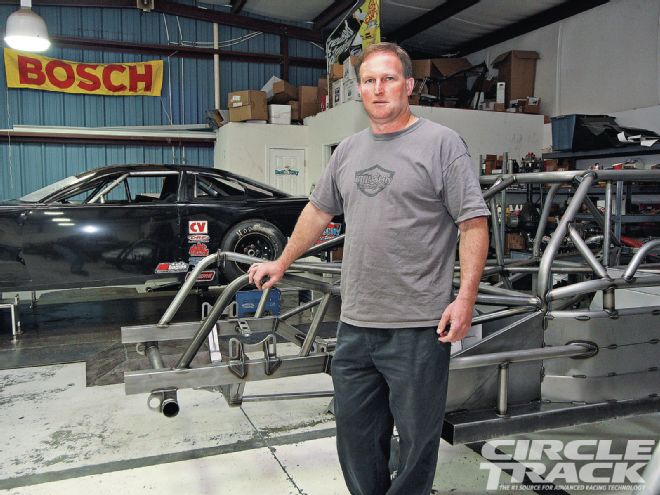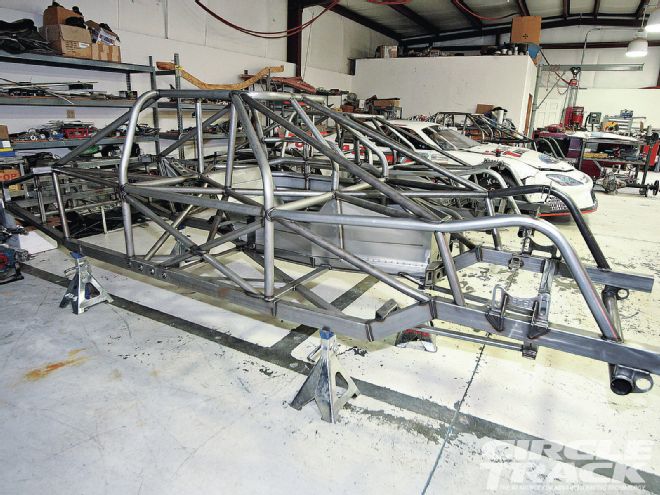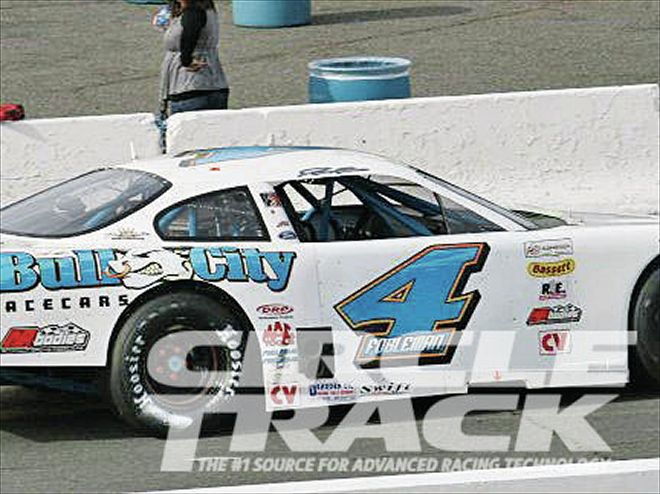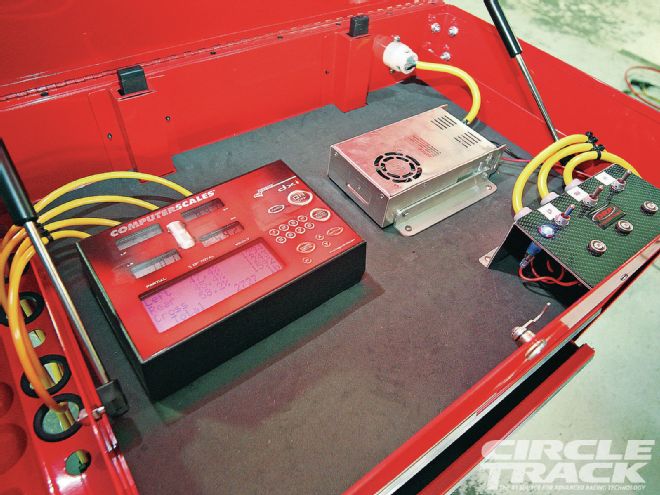
As a general rule, we have a lot of respect for anyone who races on the Saturday night level as a full-time job. Correct that, a metric ton of respect.
There's a lot of truth to the old joke about the best way to make a small fortune is to take a large fortune and go racing with it. For most of us, the costs of racing far exceed the profit. To make it work you have to be able to do practically everything yourself, have a good relationship with dependable sponsors, know how to stretch a buck and--most of all--finish well practically every time you take the green flag. And even if you're able to do all that, there's still no guarantee that any racing program will be able to pay for itself in addition to providing for your family and making the house payment.
 Bull City only plans to build straight-rail Asphalt Late Model cars so that its team members can concentrate their expertise specifically in that area. We found lots of things to really like about this clean-sheet design, especially the attention to detail. Notice the raised hoop for the upper shock mounts. This is more noticeable in this car because all the other bars rearward of the hoops have been kept as low as possible to keep the car's center of gravity down. The forward downtubes (from the halo to just behind the shock mount) are designed to help keep the front clip from flexing, which is a common problem with bumpstop cars.
Bull City only plans to build straight-rail Asphalt Late Model cars so that its team members can concentrate their expertise specifically in that area. We found lots of things to really like about this clean-sheet design, especially the attention to detail. Notice the raised hoop for the upper shock mounts. This is more noticeable in this car because all the other bars rearward of the hoops have been kept as low as possible to keep the car's center of gravity down. The forward downtubes (from the halo to just behind the shock mount) are designed to help keep the front clip from flexing, which is a common problem with bumpstop cars.
Jay Fogleman is definitely in that category. Although he has other business interests, Fogleman has been able to race and win for nearly 30 years with enough success to make it a profitable enterprise. Fogleman has raced practically everything on asphalt, including in the NASCAR Nationwide Series, but he's had his most success in the past decade racing straight-rail Super Late Models.
"For me it all comes down to what's going to be fun to race," he says. "And the Supers make for some really good racing. I race mostly in the PASS series, and they do it so that the engines have enough power so that you can pass somebody and it's not just follow-the-leader hoping somebody will make a mistake so you can move up. The crowds have been good even with the difficult economy, so I think that says a lot about the quality of racing, too."
But if you aren't on television on Sunday, making the financials work can be difficult no matter how good the racing is. That's why Fogleman has decided to use his experience as a race-winning driver, team owner, and general wrench to help other teams achieve the same success. Shark Racing Development is the result of that desire and was founded to help young racers develop their skills behind the wheel, team managers understand how to develop strong relationships with sponsors and crew chiefs grow their knowledge of how to tune a race car for the conditions. Fogleman has even begun developing a line of racing parts that will be manufactured and sold through DRP Performance Products.
"If you're moving to a new type of racing, you can waste a lot of time just trying to get to the level of other racers that have been in that class for a while," Fogleman explains. "That's a hard lesson I learned working with my son, Tate. We started him out in karts, and by the time I felt like I had learned enough to be able to set up and maintain his kart to give him a real chance against the competition he was ready to move up. Then I didn't learn my lesson and we did it again racing Bandoleros. His development as a racer didn't progress as fast as it could have because it took me a while to learn all the tricks with those cars.
"I've been racing for 29 years and have learned a lot of those lessons the hard way when it comes to racing stock cars, especially Super Late Models. If I can help somebody advance their own racing program a little bit by sharing what I've learned, then I think we're all the better for it."
One area where Fogleman separates himself from a lot of other Saturday night level racers is his understanding of how to set up a race car and drive it when racing "on the bumpstops." Bumpstop racing is essentially a response to get around a common rule stating a minimum ride height while the car goes through inspection. To get around the rule, several years ago NASCAR Sprint Cup teams began using front springs so light that they were only useful for holding the car off the ground while it was sitting still. On the track, aerodynamic downforce and g-forces in the turns pulled the front of the car down until the suspension bottomed out. At that point the only thing holding it up are the hard rubber bumpstops mounted on the shock shafts.
There are several advantages to racing with the front suspension essentially completely collapsed. Most of all, it lowers the car's center of gravity significantly. Racing on the bumpstops also reduces the car's aerodynamic silhouette, meaning less drag, and settling the car right down on the racetrack further reduces the amount of air that gets underneath the car. By keeping stronger springs in the rear, you get more rake in the car which helps keep the rear spoiler in the air for more downforce on the rear as well. And finally, while bumpstops still allow some wheel travel, it is minuscule compared to standard suspension travel. This makes setting the camber and toe easier because the limited amount of wheel movement makes dynamic wheel and toe changes almost nonexistent.
But there are also a few drawbacks--namely, that the cars are uncomfortable and often difficult to drive if you aren't familiar with how bumpstops will cause it to react. Finding the best setup with a car designed to run on the bumpstops is also quite different than a traditional chassis package.
"The material used for the bumpstops is slightly flexible so when the car is sitting on the stops, there is still some wheel movement but it is very small," Fogleman explains. "The spring rate really spikes when the car gets down on the bumpstops and that can cause a drastic change in the way the car handles. Plus, in many ways setting up the car is the exact opposite of what you would expect if you have any experience in what we will call the old style with stiffer front springs.
"For example, one situation that often throws a lot of newer drivers is the car will be loose getting into the turn, but as soon as the front end settles down on the bumpstops the wheel rate spikes and the car instantly goes tight. Traditionally, the fix for a tight car is to take some spring out of it, but that's the opposite of the correct move for a car with bumpstops. What you actually want to do is put some more spring in it to keep the car from hitting the bumpstops so hard. Now the wheel rate won't spike so high and the car won't transition from loose to tight so quickly."
It's safe to say that few people on the Saturday night level have put more effort and time into researching how bumpstops affect handling and performance on Late Model race cars. And besides helping other drivers and crew chiefs, that knowledge has also influenced how Fogleman wanted the chassis he races constructed.
"Over time I found things that I felt just worked better," he says, "and so we would make those modifications to our race cars. I wanted a chassis built to my specifications from scratch but the chassis builders I talked to didn't want to do something that was so different from their standard chassis. So I decided it was time to go out and start building my own."
That decision was the foundation for Fogleman's newest business, Bull City Race Cars. Bull City built its first chassis for Fogleman to race in the PASS Series in 2011 essentially as an R&D vehicle. But Fogleman did surprisingly well with the car and finished second overall in the point standings. "That was encouraging," Fogleman says. "I didn't want to sell anyone a chassis until we knew it could win races and compete against everything else out there, and we proved that with the season we had."
 Two lasers at the back of the car make checks at the wheels quick and easy. Fogleman aligns the right-side laser off the right framerail and the left-side laser is adjusted so that it is parallel to the right.
Two lasers at the back of the car make checks at the wheels quick and easy. Fogleman aligns the right-side laser off the right framerail and the left-side laser is adjusted so that it is parallel to the right.
Based off that success, Fogleman had already sold at least six new chassis by the time we stopped by his shops in Durham, North Carolina, to take a look at his operation. Interestingly, there was no welding or cutting when we stopped by.
"I may be in the chassis business now," he explains, "but I'm smart enough to know I'm no welder. There are a lot of people out there better at that than me, and I figure if I'm spending my days welding tubing then that's keeping me from trying to develop the car to make it better.
"I think one of my strengths is being able to put together a team of some of the best people available that work well together, and that's what we've done with Bull City Race Cars. I've teamed up with Ortec to fabricate the chassis. They do a lot of chassis development for the big NASCAR guys and their precision and craftsmanship is just excellent. They set up a jig specifically for my car and that's the only chassis built on that jig. They also have one guy that's going to do all the welding on my cars. So we know the consistency is going to be there car after car. I have somebody else manufacturing my spindles exactly to my specifications and he does a better job than I ever could if I tried to do it myself."
 The pull-down rig is controlled from this control panel in the storage/toolbox. The three toggle switches control the actuators and the readout from the scale pads is on the left.
The pull-down rig is controlled from this control panel in the storage/toolbox. The three toggle switches control the actuators and the readout from the scale pads is on the left.
After the chassis are completed, they are brought to Fogleman's shops and are built out to whatever level the customer desires. Fogleman says that if a customer wishes he can use Fogleman's own notes about racing setups. Complete race cars can also be run on Fogleman's chassis dyno and setups tuned on the shop's own pull-down rig. It's the entire racing package he says he's selling--including his accumulated racing knowledge--and not just the chassis itself.
Of course, being able to produce a quality racing chassis capable of protecting the driver and winning races is still awfully important. Fogleman says that when he began the project he would be competing against chassis builders who had spent decades refining their chassis a bit at a time. He didn't have the time for that so to catch up quickly he brought to bear the kind of technology normally associated with NASCAR Sprint Cup teams.
One major component of his chassis development program is DRP's chassis pull-down rig. While most pull-down rigs are extremely complex and extremely expensive, DRP innovative unit is portable, affordable (compared to the competition), doesn't require its own area in your race shop, and doesn't require a doctorate in physics to use effectively.
 Fogleman says he plans to help his customers with their setups and racing programs, so before he sold a single Bull City straight-rail chassis he put his design to work for a season's worth of racing so that he not only could be sure it is capable of winning races, but now he also has a complete book of notes to know how the car responds in practically any situation.
Fogleman says he plans to help his customers with their setups and racing programs, so before he sold a single Bull City straight-rail chassis he put his design to work for a season's worth of racing so that he not only could be sure it is capable of winning races, but now he also has a complete book of notes to know how the car responds in practically any situation.
Fogleman is working with DRP to develop a track telemetry system to measure suspension movement so that it can be replicated on the pull-down rig. They are also working on new devices to measure suspension movement after the car is placed on the rig. So far the rig has helped Fogleman with dialing in setups for his new chassis and he expects the improvements will continue. For example, Fogleman discovered that the standard round-tube lower control arms were flexing when they were hard against the bumpstops, so he developed a stronger square tube lower control arm for his car that allows him better control of the tire's contact patch.
We took a close look at Bull City Race Cars' setup and how it's using affordable technology to go from non-existent to winning races with its own chassis in less than a year. As companies like Bull City, DRP, and others become more innovative with the technologies that are available it will bring about many more opportunities for creative racers to find an advantage on the competition.